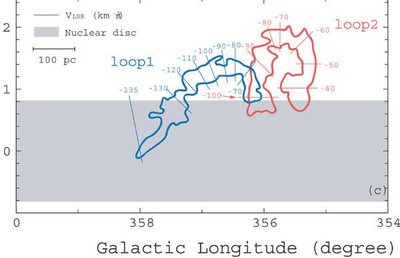Struck by loops
At the risk of turning BLDGBLOG into some sad and unofficial subsidiary of New Scientist, let me point out in any case that "[h]uge loops of gas – similar to those found on the Sun – have been found soaring above the galactic plane near the centre of the Milky Way."

"The tube-like structures may be responsible for the formation of giant star clusters near the galaxy's centre and also might be behind the region's mysteriously powerful magnetic field."
To quote the article at length:
The energy involved is extraordinary: for instance, the "observed speed of the gas as it gushes down the sides of the loops... carries roughly the same amount of kinetic energy as is produced in a supernova explosion."
This immensely powerful magnetized landscape of interstellar gas undergoes turbulence, pooling, waves, and condensation – eventually hitting a point at which stars can form, spooling themselves together gravitationally from loose strands of an ethereal topography. Structured wisps of polarized light soon shine.

There's a poem – though I can't seem to find it anywhere now – by John Burnside, which beautifully describes a sort of Christianized cosmology in which the remains of angels have been found hovering in space, titanic, made of color and transparency – and a part of me likes to think that the "glowing arches" and otherwise unexplained astral loops that New Scientist introduces us to are really part of some huge and ongoing theological archaeology of the sky. Mythic remnants: forgotten gods become astro-tectonic structures in space.
One night, a man with a home telescope discovers the chemical ruins of a church the size and shape of whole galaxies, domes of helium and osmium drifting across the outer tangents of the Milky Way – a mobile landscape that survives even universal catastrophe.

"The tube-like structures may be responsible for the formation of giant star clusters near the galaxy's centre and also might be behind the region's mysteriously powerful magnetic field."
To quote the article at length:
- "I was struck by the loops when I saw them," says study leader Yasuo Fukui of Nagoya University in Japan. "But it took a few years for me to understand that they represent magnetic loops." The team believes they formed the way glowing arches, called prominences, do on the Sun – from the stretching and bending of magnetic field lines.
The energy involved is extraordinary: for instance, the "observed speed of the gas as it gushes down the sides of the loops... carries roughly the same amount of kinetic energy as is produced in a supernova explosion."
This immensely powerful magnetized landscape of interstellar gas undergoes turbulence, pooling, waves, and condensation – eventually hitting a point at which stars can form, spooling themselves together gravitationally from loose strands of an ethereal topography. Structured wisps of polarized light soon shine.

There's a poem – though I can't seem to find it anywhere now – by John Burnside, which beautifully describes a sort of Christianized cosmology in which the remains of angels have been found hovering in space, titanic, made of color and transparency – and a part of me likes to think that the "glowing arches" and otherwise unexplained astral loops that New Scientist introduces us to are really part of some huge and ongoing theological archaeology of the sky. Mythic remnants: forgotten gods become astro-tectonic structures in space.
One night, a man with a home telescope discovers the chemical ruins of a church the size and shape of whole galaxies, domes of helium and osmium drifting across the outer tangents of the Milky Way – a mobile landscape that survives even universal catastrophe.





Comments are moderated.
If it's not spam, it will appear here shortly!
PS: News of the weird: I ran into Anthony Kiedis, from the Red Hot Chili Peppers, at an IKEA in Burbank, CA, yesterday afternoon. My first star-spotting since relocating to L.A. I said, "What's up, Anthony?" and he said, "Howdy," as he checked his mobile phone. Red Hot Home Improvement Peppers. I should have given him a BLDGBLOG sticker...
you have stickers?
Yep. Not for sale, though. I just make them myself, then hand them out. While ringing a bell in front of K-Mart. If I see you round L.A. I'll give you one.
sorry, but this is really old news and has been explained -- research plasma cosmology.
http://en.wikipedia.org/wiki/Plasma_cosmology
nevertheless, it is nice that yasuo fukui was able to pull his head out after "a few years", but computer models have already been run on this back in the early 1980's by Peratt, a student of Hannes Alfvén won the nobel prize in physics for plasma cosmology in 1970.
Jason - As far as I can tell, the "news" in this article isn't plasma cosmology itself but the specific existence of "huge loops of gas" arcing above the Milky Way. Fukui's model is thus not a representation of plasma cosmology in general but of this specific, local, electromagnetic landscape – the "hills" and "valleys" and so on of this particular force-topography.
Otherwise, thanks for the link!
Black Hole Belts Out Discordant Musical
http://www.space.com/scienceastronomy/061005_blackhole_musical.html
geoff -- good point. i just saw it as yet another example of plasma cosmology, which is usually missed by astronomers. when they say "mysterious", i say obvious:
http://antwrp.gsfc.nasa.gov/apod/ap060203.html
Holy shit! Jason, that's an amazing image.
And Ben, the b-flat singing black hole makes a cameo appearance at the end of this post. Check it out...
Post a Comment